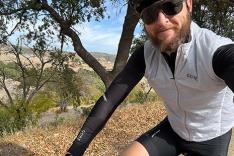It's More Than the Core
To pray successfully and safely—and I want to emphasize the word safely—you need two ingredients:
- Lots of practice, which means you become more stable and more confident. Until you are completely comfortable with the transitional set up, you may be at risk, so make sure you have it dialed even before you actually take your new skill set to the road.
- Strong stabilizer muscles of the core are just the beginning. "Core" has become a real buzz word for athletes, but very little has actually been written about the sport-specific application of core strength as used in cycling. What we need is to consistently and effectively connect those dots to fast riding. The core connection starts with a more active emphasis on rhythmical out-breath breathing. Understand that a strong core does not simply make you a more powerful cyclist. A strong core allows the possibility for a base of ancillary stability. In simple language, that means using the 30-plus core muscles including the erector spinae group and connecting them so your major muscles can freely generate a powerful stroke. Consistent deep and focused breathing and a flattened bent elbow body position will add natural core activation to the mix.
The next element is safe practice, which means saddle time, or, if you are stuck in the cold, the possibility of trying this technique on a trainer to better understand a few of the chains of mechanical and biomechanical micro-adjustments that are needed to maintain effective control of your bike in this position. On the road you and your training partners will find that holding a straight line is a real challenge and the only solution is saddle time. I lace my fingers to enhance the core connection and activate the lower leg muscles more in the hip-flexing back side of the stroke.
Under the heading of "Body FiTTE" our instructors and I work with our clients on daily core activation and a variety of stability exercises to strengthen the rectus abdominus, external obliques, and gluteus medius. Personal coaching favorites include free-form recumbent cycling while lying on the back. Other favorites include the stability ball pike, pull-up bar crunches to work the latissimus dorsi and serratus anterior which are used extensively in this new position.
In the tuck position you will find more fire in the gluteus maximus, vastus lateralis and biceps femoris, all of which can be worked well with single-leg stability exercises such as the rotating arc as beautifully illustrated in Shannon Sovndal's Human Kinetics book Cycling Anatomy. These muscles can also be worked with incline lumbar extensions. More variety of cycling specific strength and flexibility exercises can also be found in my latest book, Mastering Cycling.
A Caveat of Praying
- Never pray on anything but a predictably smooth road surfaces. In fact you need to practice quick transitions from tuck to brake hoods and back in rapid succession.
- Never, ever pray on a very fast downhill, especially when you might need to execute a committed turn.
- Avoid prayer when a strong crosswind exists. Unpredictable yaw conditions such as sharing a road with a large trucks or buses is absolutely to be avoided under penalty of death!
- It goes without saying that you never want to pray in the pack, only when you are on your own or leading a group.
Of course by the time you read this, the powers that be will probably have already decided to change the rules on us in order to outlaw my aero position and make it illegal for competition. Even if that happens, you will still be able to do some damage on training rides, and after all, what is a good training ride but a test of ego without an entry fee?
John Howard is one of the pioneers and true legends of American bike racing, with palmares including: 3-time Olympian, Ironman world champion, bicycle landspeed record, USA Cycling Hall of Fame, and elite and masters national champion. John is also an active cycling coach and the author of Mastering Cycling. Check out more information about John and his coaching at fittesystem.com and JohnHowardSports.com.
PezCycling News: We tap into what's cool in elite level pro cycling and make the news fun again -- every day. Check out our off-beat rider interviews, top level tech reviews, weekly training & fitness articles, cool stories on top rides, race news and reports the way we like 'em, the lovely Daily Distractions and cool stories you can't find anywhere else. Get Pez'd Today!
- 2
- of
- 2








Discuss This Article